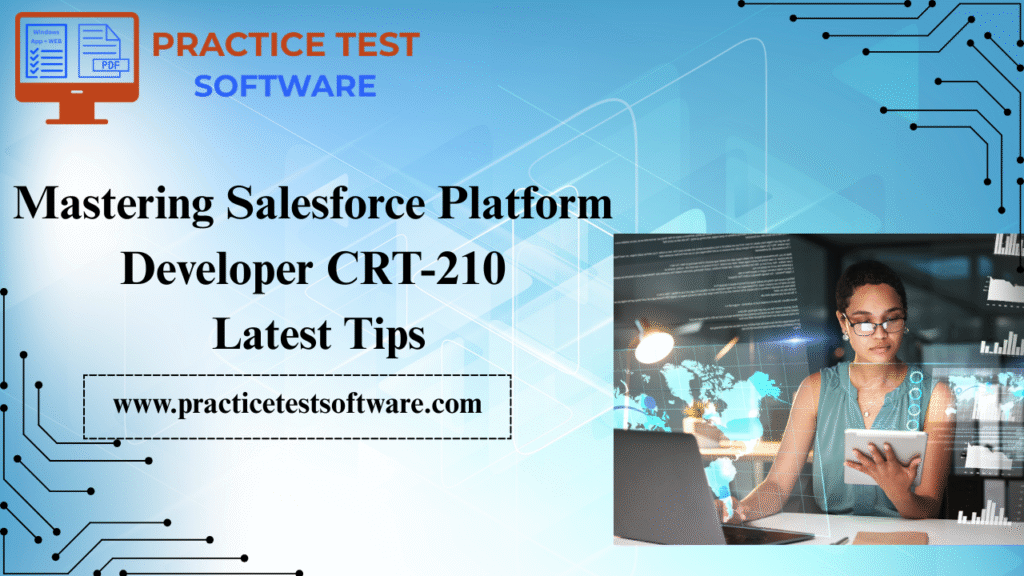Salesforce continues to dominate the customer relationship management (CRM) space, and its certifications help professionals stand out in a competitive market. The Salesforce Platform Developer I (CRT-210) exam is one of the most important credentials for developers who want to validate their skills in building custom applications on the Salesforce platform. This guide explains the exam’s objectives, content areas, and proven strategies so you can prepare effectively.

Understanding the Platform Developer I Certification
The CRT-210 certification verifies your ability to design, build, test, and deploy applications on the Salesforce platform. It focuses on Apex programming, Lightning components, Visualforce, data modeling, security, and best practices for scalable development. The goal is to show that you can extend Salesforce functionality beyond simple point-and-click tools while maintaining performance and reliability.
This certification is ideal for developers with at least six months of experience building applications using Apex, Visualforce, or Lightning. It also benefits administrators, business analysts, or consultants who want to transition into technical roles.
Exam Format
The Platform Developer I exam contains around sixty multiple-choice or multiple-select questions. You are given approximately one hour and forty-five minutes to complete the test. A passing score is about sixty-five percent, though Salesforce may adjust the threshold slightly from time to time. Candidates can take the exam online with a proctor or in person at a testing center. If you do not pass on your first attempt, you may retake it after a short waiting period.
Questions are primarily scenario-based. They assess how you apply Salesforce development concepts, not just how well you memorize terminology.
Core Knowledge Areas
Several topic domains make up the CRT-210 curriculum. One of the most important is data modeling and management. You need to understand how to design objects, fields, and relationships such as master-detail and lookup, as well as how to work with external objects and roll-up summaries. A good grasp of tools like Schema Builder and the proper handling of bulk data is also essential.
Logic and process automation form another large portion of the exam. This includes writing Apex triggers, using trigger frameworks, and working with SOQL and SOSL queries while staying within governor limits. Declarative automation tools such as flows and Process Builder also appear frequently.
Apex development itself is a major area. You should be comfortable creating classes, handling exceptions, working with collections, and applying test-driven development. Knowing how to achieve high code coverage and create reliable test data is crucial.
User interface customization is also tested. Candidates must know how to build Lightning components, both Aura and Lightning Web Components, and how to integrate them with Visualforce pages and controllers. Understanding when to use standard controllers versus custom controllers can make a difference in real-world scenarios and on the exam.
Debugging, deployment, and maintainability are smaller but significant domains. You need to use tools like the Developer Console, check debug logs, and understand deployment techniques such as change sets or the Salesforce CLI. Finally, security and access are always relevant. You must apply profiles, permission sets, sharing rules, and field-level security appropriately in both declarative and programmatic solutions.
Click Here to Get More Info:
https://www.practicetestsoftware.com/salesforce/plat-dev-210
Preparation Strategies
Success on the Platform Developer I exam comes from combining theory with practice. Start by reviewing the official Salesforce exam guide and documentation. Salesforce Trailhead offers interactive modules on Apex, Lightning, data architecture, and automation tools, which provide an excellent foundation.
Hands-on practice is essential. Create a free Developer Edition org and build small projects. Write triggers, create Lightning components, experiment with flows, and perform data migrations. Practice writing SOQL and SOSL queries against real data. This experience will help you understand how concepts behave in live environments.
Take advantage of practice exams or mock tests. These simulate the exam format and highlight areas where you need improvement. Study the explanations for both correct and incorrect answers so you understand the reasoning behind each choice.
Participate in Salesforce community groups or online forums. Experienced developers often share common pitfalls and tricky topics, which can help you prepare for unexpected questions. Reading blogs or developer success stories can also inspire more efficient study methods.
Finally, focus on best practices such as governor limits, bulkification of triggers, and separation of concerns in code. Clean, efficient solutions are not only rewarded on the exam but are essential for real-world success.
Avoiding Common Mistakes
Even well-prepared candidates sometimes lose points because of recurring errors. One common mistake is ignoring governor limits, which can cause code to fail when processing large data volumes. Always write triggers and queries with scalability in mind.
Another frequent issue is insufficient test coverage. Tests must include positive and negative paths, bulk data, and exception handling. Aiming for clear assertions and at least seventy-five percent coverage is advisable.
Many candidates forget the Salesforce order of execution, which determines how triggers, workflows, and automation fire. Since several exam questions rely on this sequence, take time to memorize and practice it.
Security is another area where people slip up. Failing to check object or field-level security in Apex can lead to vulnerabilities. Always respect CRUD and FLS permissions when writing code.
Finally, remember that not every solution requires Apex. Sometimes declarative tools like Flow or Process Builder provide cleaner, easier options. Understanding when to choose a declarative versus programmatic solution is part of being an effective developer.
Click Here to Get More Info:
https://www.practicetestsoftware.com/salesforce/plat-dev-210
Sample Study Timeline
Although study schedules vary, an eight-week plan works for many candidates. Begin by reading the exam guide and completing introductory Trailhead modules on data modeling and security. Next, focus on SOQL, SOSL, and Apex basics such as triggers, classes, and collections. Gradually incorporate Lightning components and user interface customization. Spend time on flows and process automation, then shift to testing, debugging, and deployment. In the final weeks, review weak areas, memorize key limits, and take full practice exams.
Tips for Exam Day
On the day of the test, make sure you are well rested and calm. Read each question carefully, paying special attention to multi-select questions where all correct answers must be chosen. Manage your time wisely, moving on from any question that takes too long and returning later if you have time left. Trust your preparation and avoid overthinking.
Why Earning This Certification Matters
Obtaining the Salesforce Platform Developer I credential demonstrates more than just technical knowledge. It proves your ability to create reliable, maintainable solutions in a professional environment. Employers value certified developers because they can confidently handle automation, integration, and security challenges. Certification may open doors to better job opportunities, higher salaries, and advancement to more complex Salesforce roles, such as Platform Developer II or Technical Architect.
The Salesforce Platform Developer I (CRT-210) exam is a rewarding milestone for anyone aiming to excel in Salesforce development. With consistent study, practical experimentation, and awareness of best practices, you can pass the exam and strengthen your career prospects. By mastering the skills required—data modeling, logic, automation, user interface customization, and security—you not only prepare for certification but also develop the confidence to build scalable, high-quality applications on the Salesforce platform.


